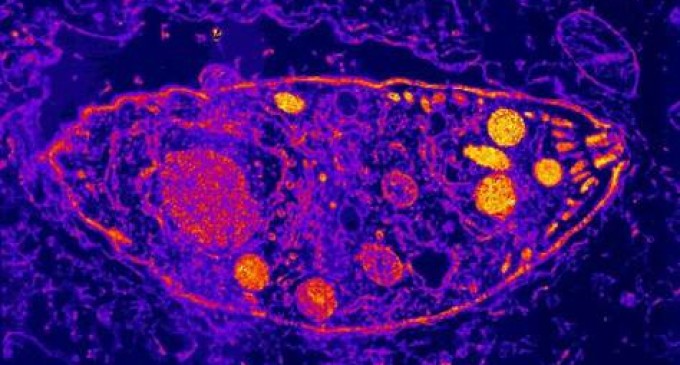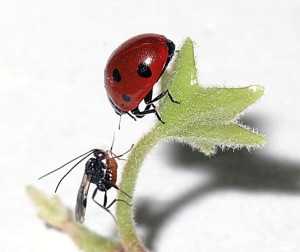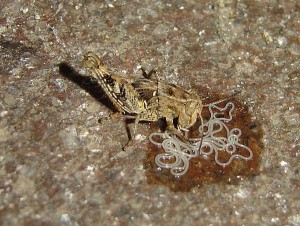Mind Control in the Real World – Puppeteer Organisms

In honor of Halloween, I bring you a terrifying list of six organisms that can control the minds of other creatures. A “puppeteer organism” is a parasite capable of controlling its host’s brain. Terrifying thought, isn’t it? But what’s worse is that the host doesn’t even know it’s being controlled. This idea doesn’t come from a science fiction novel, it comes from real life. Take for example the Toxoplasma gondii parasite.
Toxoplasma Gondii Parasite
Known as “T gondii,” this microscopic mind controller has the ability to mute fear in rats and mice. When the unlucky critters consume T gondii, they are no longer afraid of predators like cats. This lack of fear often leads to their deaths. T gondii then ends up in litter boxes and although the parasite’s effects on the human mind are subtle, doctors recommend that pregnant women avoid changing cat litter.
The Ladybug Killer
 The Dinocampus coccinellae is a parasitic wasp that creates zombie bodyguards by injecting innocent ladybugs with the D. coccinellae virus. The virus then attacks its host’s nervous system and paralyses it. Occasional spasms give the illusion of life, but for all intents and purposes the host becomes a zombie, its only function being to protect wasp larvae from enemies.
The Dinocampus coccinellae is a parasitic wasp that creates zombie bodyguards by injecting innocent ladybugs with the D. coccinellae virus. The virus then attacks its host’s nervous system and paralyses it. Occasional spasms give the illusion of life, but for all intents and purposes the host becomes a zombie, its only function being to protect wasp larvae from enemies.
When the infant wasps hatch, they show their gratitude by eating their ladybug babysitters. And now the really weird part: nearly one third of the ladybugs that survive the ordeal go on to make a full recovery.
Costa Rican Bully
Another parasitic wasp, the Hymenoepimecis argyraphaga, forces spiders to spin their own coffins. The wasp’s prey is a spider known as Plesiometa argyra. With a paralyzing sting, the wasp immobilizes the spider and lays an egg in its belly.
When the spider wakes up, it is unaware that a wasp larva is busy sucking its blood. When the larva has filled up on spider blood, it injects the poor creature with a chemical that forces it to build a strong but unnatural web. When it’s finished, the spider remains motionless until death comes in the form of poison from the larva. The infant wasp then builds a cocoon in the sturdy, subcontracted web.
Junk in the Trunk
In the first-ever discovered example of “fruit mimicry,” the nematode Myrmeconema neotropicum (a type of roundworm) infects Cephalotes atratus ants, literally giving them “junk in the trunk.” When an ant consumes bird droppings infected with the nematode, its rear end swells to huge proportions – looking exactly like a juicy red berry. Birds eat the “berries” and are infected with the roundworm, continuing the cycle.
Cricket Suicide
 “Some parasites can alter the behavior of their host in ways that give the parasite a better home, or provide more nutrients, or cause the host to move to a different environment,” says Janice Moore, Colorado State University biologist. “A parasite that can alter the behavior of its host, and in doing so improve its own transmission, is going to be favored by natural selection.”
“Some parasites can alter the behavior of their host in ways that give the parasite a better home, or provide more nutrients, or cause the host to move to a different environment,” says Janice Moore, Colorado State University biologist. “A parasite that can alter the behavior of its host, and in doing so improve its own transmission, is going to be favored by natural selection.”
The Spinochordodes tellinii hairworm (pictured at left) spends most of its life wriggling around in a puddle, reproducing and waiting for an unsuspecting animal to drink. In order for an infant to grow into an adult, it needs to get inside a living host.
The Spinochordodes tellinii likes to prey on unsuspecting crickets, entering their bodies when they stop for a drink. The worm, now inside the cricket, must eventually return to the water to continue its life. When it’s feeling dry, the spinochordodes tellinii releases a mind-control chemical into the cricket’s brain, forcing it to take a swim in the next available body of water. The only bad part is that crickets can’t swim. The cricket, compelled to jump into the water, drowns. The adult hairworm then emerges from the dead body and continues its life in the water.
Click here to check out a National Geographic video about a flatworm called the liver fluke. It enslaves ants in order to travel from one host to another and has been known to decimate entire herds of cattle.
General Acacia
The acacia tree might look beautiful, but it has a crafty way of protecting itself from harm: it recruits an army of ants.
Ants love the acacia tree for its sugary nectar – and they don’t like any other creature having a share. While this might seem like a coincidence, research shows that the nectar actually makes the ants more aggressive. With enough ants, this resourceful tree can ward off anything from a spider to a giraffe.
When its time to pollinate, the tree releases a chemical that drives the ants crazy and makes them leave. Because the chemical is attached to the the pollen, the ants come back when the pollen disappears, completely oblivious to what happened.
According to biologists, these freaky organisms are favored by natural selection and will continue to thrive. Let’s just hope they don’t find a way to prey on humans!










